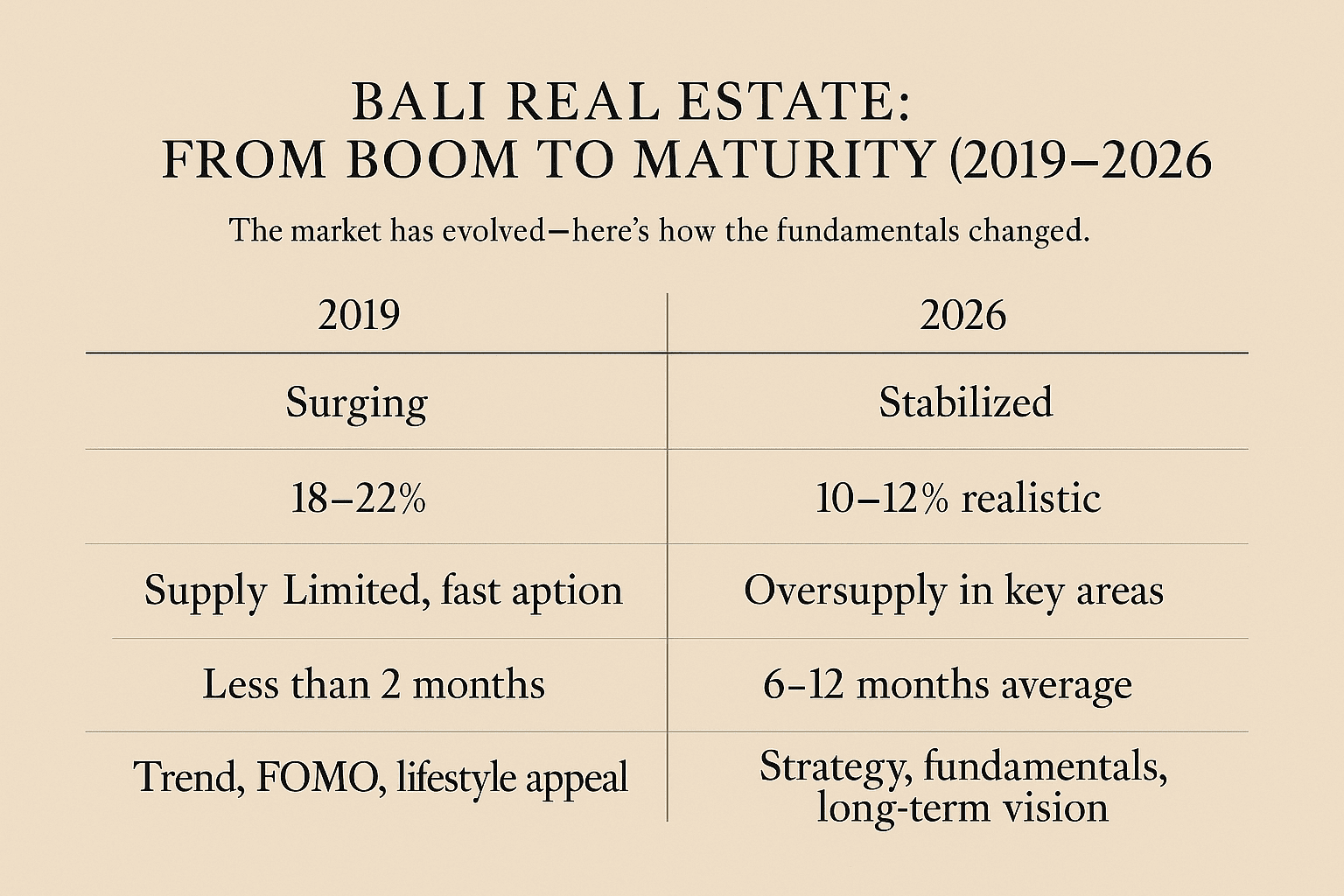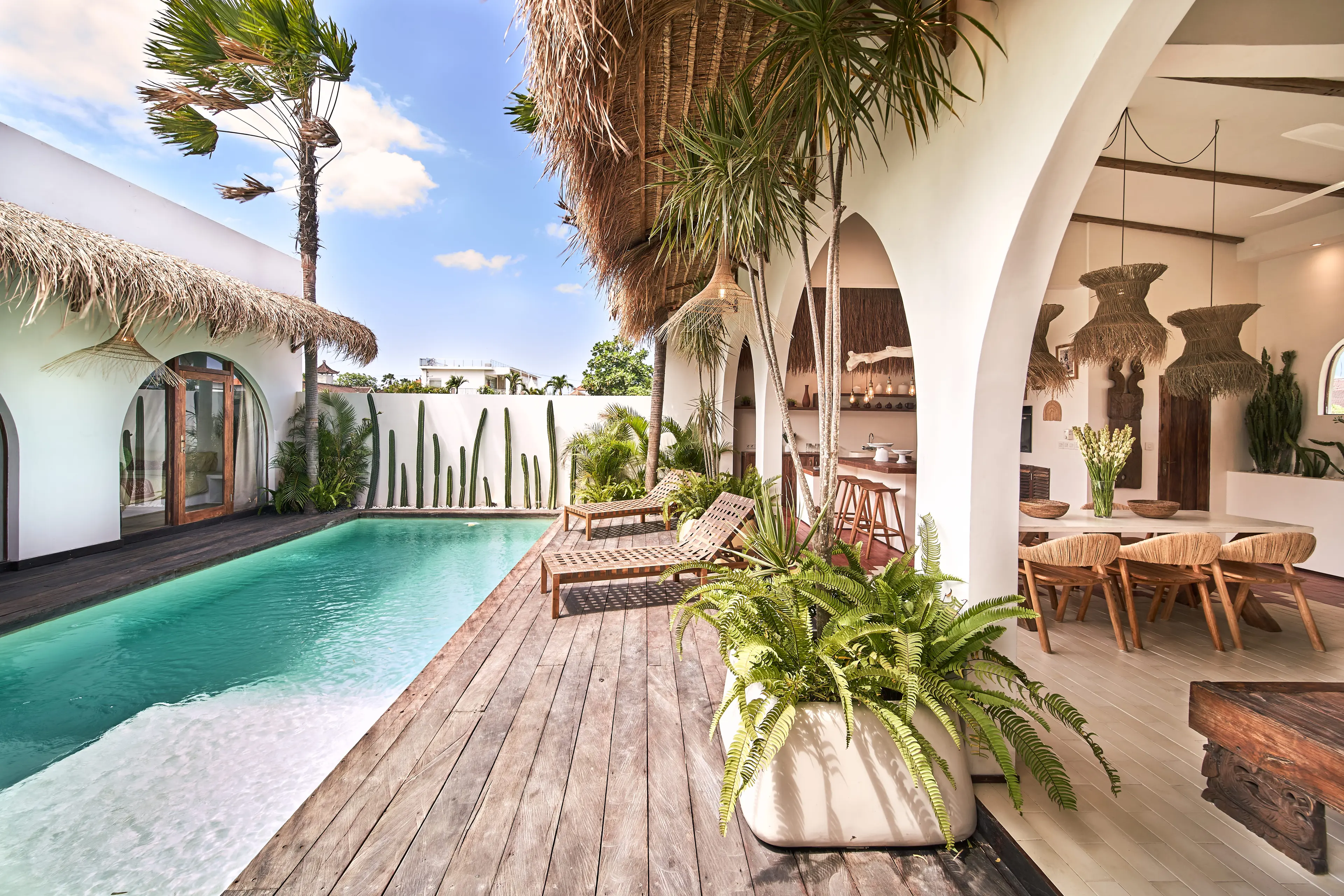Introduction
The Bali real estate boom of the past few years has transformed the island's landscape—but the game has fundamentally changed. Properties have soared in value, leading to an oversupply and declining demand. The "trendy wave" is over, and the easy wins are gone.
If you're considering buying, investing, or developing property in Bali in 2026, this is a critical moment to recalibrate your strategy. Success is no longer about jumping on a trend or capitalizing on hype. It's about smart decisions, realistic expectations, and understanding what truly creates long-term value.
This guide reveals what you need to know to navigate Bali's real estate market in 2026—and how to thrive in an increasingly competitive landscape.
The New Reality: Understanding Bali's Market Maturation

What Changed?
The property market in Bali has matured significantly. After years of explosive growth, we're now seeing:
- Oversupply: More properties available than buyers willing to purchase
- Decreased demand: The rush to invest in Bali has cooled
- Longer sales cycles: Properties are taking longer to move
- Lower returns: Gone are the days of 20% ROI; realistic returns now range from 10-12%
This isn't a crisis—it's a market correction. And for savvy investors and buyers, it's an opportunity to make decisions based on fundamentals rather than FOMO.
The Key Principle: It's What You Do, Not Just Where You Do It
In a hot market, location alone could carry a property. Today, your strategy matters more than ever. Your competitive advantage comes from how you approach your investment or development—not just the address.
Location Strategy: Choosing Where to Buy
While "what you do" is paramount, location remains essential. However, the way you think about location has evolved. Here's how to evaluate Bali's key areas in 2026:
Uluwatu: Premium Positioning is Essential
Uluwatu remains one of Bali's most sought-after areas, but it's increasingly crowded. To succeed here:
- Ocean views are non-negotiable: Properties without significant ocean views face significantly longer sales times
- Cliff-front positioning is ideal: The most coveted properties are those with dramatic cliff-front locations
- Build for luxury, not budget: Mid-range properties struggle; invest in premium finishes and amenities
Best for: Luxury investors seeking high-end short-term rental potential or long-term residence
Ubud: Stay Strategic
Ubud's growth has brought both opportunity and crowding. To position yourself effectively:
- Central location is critical: With traffic increasing dramatically, proximity to Ubud's center now matters more than ever—travel times from the outskirts can easily double during peak hours
- South of Ubud is ideal: Properties located in the southern part of Ubud offer better access to the airport and Ubud's main attractions
- Consider accessibility: Easy access to restaurants, spas, yoga studios, and cultural experiences
Best for: Investors targeting the wellness and cultural tourism market, families seeking community
Take a minute to check out our selection of the best villas currently for sale in Ubud. Click here.
Canggu & Seminyak: Zone by Purpose
Canggu's diversity is an asset—but choosing your microzone matters:
- Right outside the Raya: Ideal for families seeking a residential feel with proximity to amenities
- Heart of Canggu: Perfect for those targeting tourists and short-term renters, with vibrant nightlife nearby
- Avoid immediate proximity to nightclubs: Properties too close to the party scene may face noise complaints, regulatory issues, and declining long-term appeal
- Renovation opportunity: Both Canggu and Seminyak offer strong potential for renovations—upgrading older properties with modern design and amenities can unlock significant value
Best for: Developers and investors with diverse target markets, renovation specialists
Sanur: The Family & Retiree Haven
Sanur is quietly becoming one of Bali's most compelling markets:
- Built for families and retirees: Peaceful atmosphere, beachside living, and established infrastructure
- Growing market with limited supply: Demand is increasing while available properties remain constrained
- Beach access: Direct beachfront or near-beach properties command premium positioning
- Strong long-term rental potential: Perfect for families settling in Bali for extended periods
Best for: Investors targeting stable, long-term tenants; developers focused on family-oriented properties
Other Locations Worth Exploring
Nusa Penida: Long-Term Potential
- Limited supply, growing tourism, infrastructure developing
- Best for risk-tolerant investors with 5-10 year horizons
Nusa Lembongan: Already Booming
- Established tourism market with limited supply
- Strong rental potential with existing infrastructure
Sidemen & Karangasem: Cautious Optimism
- Sidemen is already crowded with limited upside potential
- Strong for wellness and cultural tourism, but niche market
Tabanan: Eco-Tourism & Retreats
- Perfect for eco-resorts, bamboo villas, and retreats
- Product-market fit is critical—align with eco-tourism niche
The Four Pillars of Success in 2026
To compete in today's market, focus on these critical factors:

1. Accessibility to Bali's Hotspots (Location)
Easy access to restaurants, spas, beaches, activities, and cultural experiences is non-negotiable. Consider commute times, infrastructure, and proximity to amenities when evaluating a location. This isn't just about being "near" something—it's about real, practical accessibility that enhances daily living and guest experiences.
2. Over-the-Top Service (Experience)
Exceptional service is what separates thriving properties from struggling ones. In a saturated market, the experience you deliver matters as much as the property itself. Think beyond standard hospitality—offer responsiveness, personalized touches, curated local experiences, and genuine care. Property management excellence is no longer optional; it's a competitive necessity.
Check out Bali Super Host if you want your villa managed by experts. Click here.
3. Top Quality Property (Cheap Doesn't Sell Anymore)
People want quality, period. Budget and mid-range properties are struggling to sell and rent. Invest in premium materials, thoughtful finishes, reliable infrastructure, and attention to detail. Cutting corners to save costs will cost you far more in lost sales, lower rental rates, and property value depreciation. Quality is the new baseline.
Design and views remain essential but are no longer enough on their own to compete. Great design and exceptional views (or curated gardens and architectural framing for properties without natural vistas) are table stakes—you need them, but they won't differentiate you alone.
4. Long-Term Flexibility
The days of single-purpose properties are ending. Today's successful properties must adapt:
- Hybrid rental models: Many villas now operate as both short-term rentals and long-term leases
- Multi-use potential: Properties that can serve different purposes (residence, rental investment, retreat space) have greater resilience
- Seasonal flexibility: Plan for fluctuating rental seasons and adjust your business model accordingly
Who's Buying Now? Recognizing Emerging Market Segments

The Family Wave
Bali is experiencing a significant influx of families—remote workers, entrepreneurs, and retirees seeking better quality of life, lower costs, and community. This segment has different needs:
- Proximity to international schools
- Safe, family-friendly neighborhoods
- Access to schools, healthcare, and reliable infrastructure
- Sense of community and social opportunities
Developers and investors who cater to this market segment are finding strong, consistent demand. This is a less glamorous niche than luxury tourism, but it's remarkably resilient.
What NOT to Do: Lessons for Developers
Don't Expect Off-Plan Sales Anymore—Have Capital or Strong Marketing
The days of pre-construction presales are largely over. Buyers want to see finished properties or at least significant progress. If you're developing property in Bali:
- Have capital ready to start building: Don't rely solely on presales to fund construction
- Or have exceptionally strong marketing: If you must sell off-plan, you need more than just a villa—you need to sell a story, a vision, and trust
- Don't rely only on agencies: Having your own marketing strategy is a game changer in today's market
- Build trust and reliability: Buyers today demand flexibility, transparency, and proven track records from developers
- The barrier to entry has risen: The times when anyone could be a developer are over—professionalism matters
Bottom line: Today's successful developers combine financial strength, marketing sophistication, and operational excellence.
Don't Ignore Permits and Regulations
The government is intensifying enforcement against improperly permitted buildings. This trend will only continue:
- Get proper permits upfront: The cost is worth avoiding legal issues later
- Work with experienced legal advisors: Navigating Bali's regulatory landscape requires expertise
- Factor compliance into your timeline: Permits take time; plan accordingly
Setting Realistic Expectations: ROI and Returns
Let's be honest about returns. If you're investing in Bali real estate in 2026, abandon the dream of 20% annual ROI.
Realistic expectations for 2026:
- 10-12% annual return: This is a solid, achievable target for well-positioned properties
- Includes both appreciation and rental income: Most returns come from a combination of property appreciation and rental revenue
- Varies by strategy: Families buying to live typically focus on quality of life; investors must balance rental income with long-term appreciation
- Long-term horizon required: Three to five years minimum to realize meaningful returns
These numbers aren't glamorous, but they're sustainable and grounded in market reality.
The North: Opportunity with Patience
Northern Bali represents genuine opportunity for the right investor, but it's not for everyone.
Why the North?
- Strategic development plans: The new airport would transform accessibility and demand
- Lower property costs: Land and villas are significantly cheaper than South Bali
- Room for growth: Unlike the South, the North hasn't reached oversaturation
- Long-term value creation: Early movers in promising locations could see meaningful appreciation
The Caveat: This Requires Patience
- ROIs are still low: Don't expect double-digit returns immediately
- Infrastructure is developing: Roads, utilities, and services aren't as mature as South Bali
- Regulatory uncertainty: Development plans may shift
- Long holding periods: You may need to hold for 5-10 years to realize value
The north is for sophisticated, long-term investors—not quick flippers. If you have capital, patience, and a vision for where Bali is heading, the north deserves serious consideration.
Three Perspectives on Long-Term Value
As you navigate Bali's real estate market in 2026, consider value from three angles:
1. Long-Term Value for Investors
How do you maximize ROI while managing risk? Focus on properties with strong fundamentals: exceptional location, great design, consistent rental demand, and flexibility to adapt to market changes. Think about liquidity—can you exit this investment if needed in 5-10 years? Sometimes, freehold properties in growing sub-markets offer better long-term security and exit options than leasehold in saturated areas. Diversify by area and property type to spread risk. Most importantly, invest with a 5-10 year horizon and always have a potential exit strategy in mind.
2. Long-Term Value for Tourism
Bali's tourism market is saturated, but demand for exceptional experiences remains strong. It's not just about design and location—it's about the overall experience you deliver. Think beyond the property itself: How do you serve tourists so they have an unforgettable stay? Offer unique services, responsiveness, and transparency. Think outside the box—curated experiences, local partnerships, personalized touches that create emotional connections. This is where a great property manager makes all the difference. The best properties combine beautiful design with operational excellence that turns first-time guests into repeat visitors and brand advocates.
3. Long-Term Value for Bali
Finally, consider Bali itself. The island has finite resources—land, water, infrastructure capacity, cultural preservation. Think about what you bring to the island, not just the concrete you pour. Properties developed with sensitivity to Bali's environment, community, and culture will have enduring value. Developments that ignore these considerations face increasing regulatory scrutiny and long-term reputational risk. Ask yourself: Does this project enhance Bali's appeal, or does it extract value without giving back?
The three perspectives often align: what's good for Bali is good for tourism, which is good for investors.
Key Takeaways: Your 2026 Action Plan
- Abandon the FOMO mentality: The boom is over; success now requires strategy, not hype
- Focus on strategy, not just location: What you do with the property matters as much as where it is
- Invest in quality fundamentals: Design, views, accessibility, and flexibility separate winners from losers
- Recognize emerging markets: Families represent consistent, underserved demand
- Set realistic expectations: 10-12% ROI is solid; 20% is a fantasy
- Explore the north strategically: Opportunity exists for patient, sophisticated investors
- Prioritize compliance: Regulatory enforcement is increasing; proper permits are non-negotiable
- Think long-term: Five to ten-year horizons are the new standard
Final Thoughts
Bali's real estate market in 2026 is mature, competitive, and honest. The get-rich-quick days are behind us. But for investors and developers who understand the market's evolution and approach with solid strategy, realistic expectations, and a long-term vision, there's still tremendous opportunity.
The properties that will thrive—and the investors who will profit—are those that combine strategic thinking with execution excellence. It's about creating genuine value: for residents, for guests, for the market, and for Bali itself.
At Tipi Estate, we specialize in helping discerning investors and buyers navigate this complex landscape. We understand Bali's market deeply, we set realistic expectations, and we help you make decisions based on fundamentals, not trends. Whether you're looking to invest wisely, find your dream home, or develop property strategically, our team combines local expertise with international perspective to guide you.
Ready to explore your real estate options in Bali with a partner who understands the market's evolution?


Contact Tipi Estate today to discuss your property goals, explore strategic opportunities, and discover how we can help you build long-term value in Bali's dynamic real estate market.










